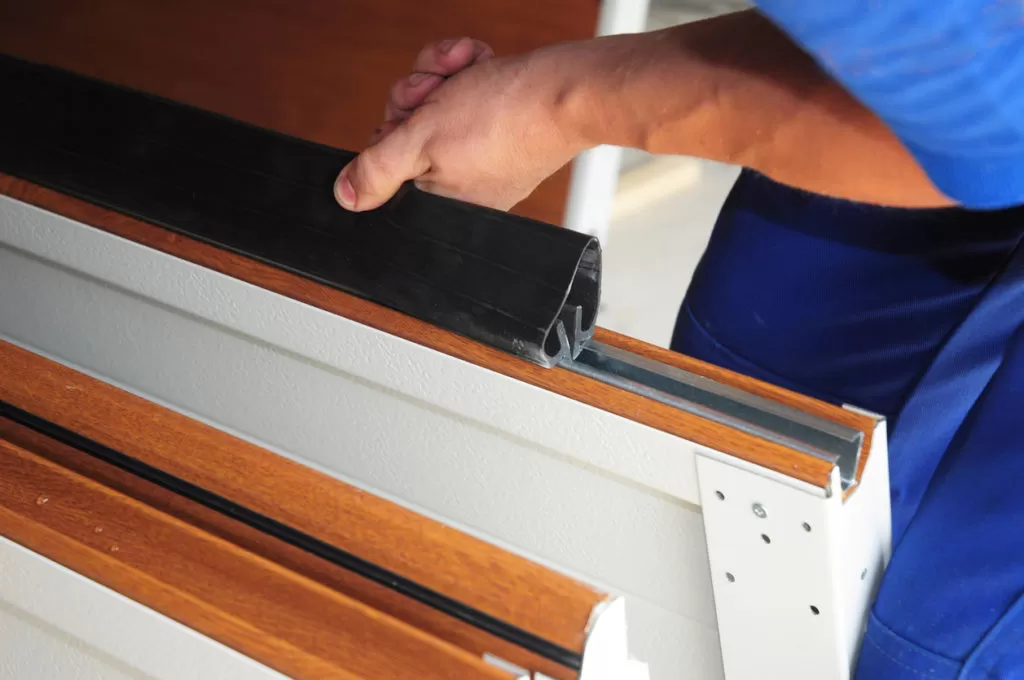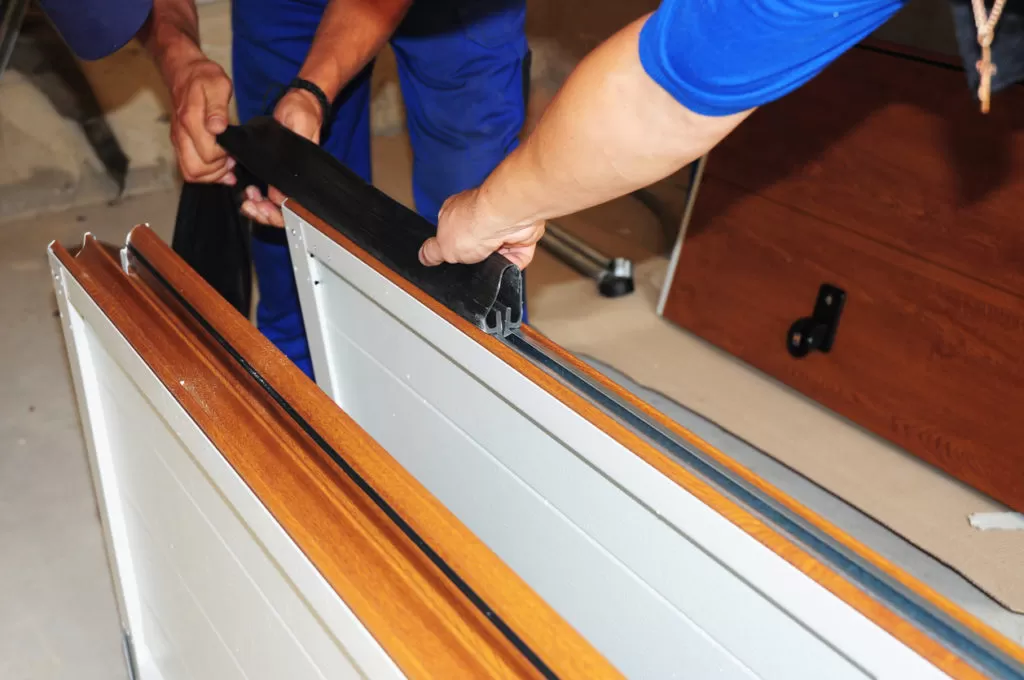Are you tired of freezing temperatures or sweltering heat invading your garage? Do you cringe at the sight of water seeping in during heavy rain?
It’s time to put an end to these issues!
Learn how weatherproofing your garage door can protect your belongings, save money, and improve your home’s energy efficiency.
Why is weatherproofing a garage door important?
Many homeowners overlook the importance of a well-insulated and sealed garage door, leading to uncomfortable temperatures, higher energy bills, and potential damage to stored items.
Weatherproofing your garage door is a simple, cost-effective solution to these problems, ensuring your garage remains a functional and protected space.
How to weatherproof a garage door
Weatherproofing a garage door involves several steps to ensure it is well-sealed and insulated against outside elements.
Here’s a step-by-step guide to weatherproofing a garage door:
1. Inspect the garage door
Check for gaps, cracks, and areas where drafts can enter. Look for signs of wear or damage on the existing weatherstripping and seals.
2. Clean the surfaces
Before applying any new weatherproofing materials, clean the garage door surfaces to ensure proper adhesion. Use a mild detergent and water to clean the door, and let it dry completely.
3. Choose the right materials
Select weatherstripping, insulation, and other materials suitable for your garage door type (e.g., steel, wood, or aluminum). Consider the climate in your region when choosing materials.
4. Install weatherstripping
Top and side weatherstripping: Attach weatherstripping along the top and sides of the door, cutting it to the appropriate length. Nail or screw the weatherstripping into place, ensuring a tight seal against the door frame.
Bottom weatherstripping: Attach a new rubber or vinyl seal to the bottom of the door. You may need to remove the old seal first. Ensure the new seal is the correct length, forming a tight seal with the ground.
5. Insulate the garage door
Choose the appropriate insulation material (e.g., fiberglass, foam board, or reflective foil) depending on your garage door type. Cut the insulation to fit each panel or section of the door, and secure it using adhesive, clips, or fasteners.
6. Install door sweeps and thresholds
If necessary, add a door sweep to the bottom of the garage door to further prevent drafts. Install a threshold along the garage floor to create a seal when the door is closed.
7. Seal gaps and cracks
Use caulk or expanding foam to fill gaps or cracks around the garage door frame or between door panels.
8. Regular maintenance
Periodically inspect and replace worn weatherstripping, seals, and insulation materials. Check for new gaps or cracks and address them promptly.
By following these steps, you can effectively weatherproof your garage door, improving energy efficiency and protecting the contents of your garage from the elements.
If you need help, consider contacting a garage door professional.
The benefits of weatherproofing your garage door
Weatherproofing a garage door is essential for several reasons, many of which aren’t related to weather.
Whether you’re a new homeowner or purchasing a new garage door, it’s essential to consider the benefits of weatherproofing your garage door. Here’s a quick list of benefits we share with clients whenever they ask if weatherproofing is necessary:
- Energy efficiency
- Comfort
- Protection from the elements
- Improved durability
- Pest control
- Noise reduction
- Enhanced home security
Energy efficiency: A well-sealed and insulated garage door helps prevent drafts and heat loss, reducing energy consumption and lowering utility bills. This is particularly important if the garage is attached to the house, as temperature fluctuations in the garage can impact the home’s overall energy efficiency.
According to the U.S. Department of Energy, proper weatherproofing can save homeowners 10-20% on their heating and cooling bills.
Comfort: Weatherproofing the garage door can help maintain a more comfortable temperature in the garage, making it a more pleasant space for working on projects, storing temperature-sensitive items, or using it as an additional living area.
Protection from the elements: An adequately sealed garage door can help prevent water, snow, and debris from entering the garage, protecting your belongings from potential damage caused by moisture, pests, or other environmental factors.
Improved durability: Weatherproofing materials, such as weatherstripping and seals, can help protect the garage door and its components from wear and tear caused by exposure to the elements. This may extend the door’s lifespan and reduce the need for repairs or replacements.
Pest control: A well-sealed garage door can deter pests like rodents and insects from entering your garage, reducing the risk of infestation and potential damage to your belongings.
Noise reduction: Weatherproofing materials can help dampen outside noise, making your garage and adjacent living spaces quieter and more peaceful.
Enhanced home security: A tightly sealed garage door can make it more difficult for intruders to access your garage and your home.
Take action today and transform your garage into a comfortable, energy-efficient, and secure space by weatherproofing your garage door. Protect your investment and enjoy the benefits for years to come.
How long do garage door weatherproof materials last?
The lifespan of garage door weatherproofing materials can vary depending on factors such as the type and quality of the materials, climate, and frequency of use.
Here are some general guidelines for the lifespan of common weatherproofing materials:
Weatherstripping and seals:
Rubber or vinyl: These materials typically last 3 to 5 years but may need replacement sooner in extreme climates or with heavy usage.
Silicone or other high-performance materials: These weatherstripping and seals can last up to 10 years or more, depending on the specific product and usage conditions.
Insulation materials:
Fiberglass: Fiberglass insulation can last up to 20 years or more if properly installed and maintained. However, it may become less effective if exposed to moisture or damaged by pests.
Foam board: Rigid foam board insulation can also last up to 20 years or more with proper care. Like fiberglass, its effectiveness may diminish if exposed to moisture or damaged.
Reflective foil: This type of insulation can last 10 to 15 years, but its lifespan may be reduced if damaged or torn.
To maximize the lifespan of your garage door weatherproofing materials, perform regular maintenance, promptly address any issues, and use high-quality materials suited to your climate and garage door type. Remember that these guidelines are general estimates, and the actual lifespan of weatherproofing materials may vary based on individual circumstances.
Consider scheduling a garage door inspection at least once yearly for the best results. At Your Garage Door Guys, we provide a 25-point inspection to ensure your garage is in excellent condition and working correctly.
Conclusion
Weatherproofing your garage door is a wise investment that brings numerous benefits, from energy efficiency and comfort to protect against the elements and improved security. Don’t let another season go by with a poorly insulated and sealed garage door. Take control of your home’s energy usage, protect your valuable belongings, and create a more comfortable space for you and your family.
If you’re ready to start enjoying the benefits of a weatherproof garage door but need professional assistance, don’t hesitate to contact Your Garage Door Guys. Our team of experts is here to help you choose the right materials and ensure proper installation for maximum effectiveness. Get in touch with us today, and let us guide you through the process of transforming your garage into the comfortable, efficient, and secure space it deserves to be.


